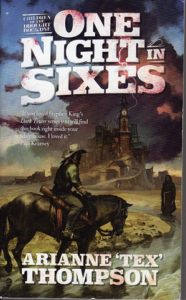Book Review: One Night in Sixes by Arianne “Tex” Thompson
Island Town used to be known as Sixes, when the Eadan Confederacy controlled this area. But a decade or so back, the indigenous peoples pushed the Confederacy across the river. Now Island Town is on the border, with only a handful of the old inhabitants providing continuity. Like many border towns, the former Sixes is a mix of various peoples with different customs and languages, who cooperate or clash in many ways.
Sil Halfwick knows nothing of conditions in Island Town–not even its new name. The sickly displaced Northerner was hoping to sell some horses at the County Fair to show his business acumen and earn enough money to move back East. That didn’t work out, so he gets the hare-brained idea to go across the border to Sixes, where horses are scarce. He drags along mixed-race ranch hand Appaloosa Elim, who Sil is nominally in charge of, but considers himself Sil’s babysitter.
Elim has good reason to worry. Across the border, “mules” such as himself are regarded with extreme suspicion due to the belief they carry disease. And if that wasn’t enough, certain people in Island Town have cause to be on the outlook for someone like Elim.
Sil is oblivious to all this. He samples the local nightlife and becomes involved in high-stakes gambling. He seems to win big, but a series of coincidences and petty cruelties result in a man being dead in the morning. Now the two outsiders are in deep, deep trouble. And it looks like neither Sil’s fast talking nor Elim’s steadfast endurance is going to get them out of it.
This Western-flavored fantasy is the first in the “Children of the Drought” series. Despite many similarities, this is not Earth as we know it. The various kinds of humans have supernatural talents, and some of the people in Sixes aren’t strictly speaking human. The “white” people speak Ardish, which is not quite English, while the trade language is the not-exactly Spanish tongue Marin. (There’s a glossary and list of characters in the back. The latter is mildly spoilery.)
One of the big differences is that it’s much harder for mixed-race people to “pass”, as instead of melding features, they wind up with vitiligo-like mottled skin. Elim has a very conspicuous eye-patch marking.
The story is told in tight third-person, with switches in viewpoint character revealing new information and making motivations clearer. We see that much of the tragedy in the story comes from people’s biases blinding them to the good intentions or full humanity of others.
In addition to Sil and Elim, we hear the thoughts of:
Twoblood, the other mixed-race person in town. She’s Second Man (effectively sheriff) and feels the need to be seen to enforce the law rigorously to offset the suspicion against her because of her ancestry.
Fours, the livery owner who is not what he seems and has conflicting loyalties. As a result, Fours has to work against his personal agenda from time to time.
Dia, the only Afriti (black person) in town. She’s a grave bride of the Penitent religion (roughly Catholic nun) and wants to give mercy where she can, but the wickedness in Island Town often thwarts her.
And Vuchak, a member of the a’Krah tribe (followers of Crow) who works in the local den of sin. He’s poor-tempered, even with his partner Weisei (who’s a trifle addlepated.) Vuchak takes his tribe’s honor very seriously, and doesn’t like compromises.
There’s quite a bit of world-building and examination of culture clash. The book ends as several characters leave Sixes/Island Town for a long journey that will presumably be the focus of the next book, but there are indications that those who died in this book will still have an effect.
There’s some rough language, and discussion of slavery. (Sil claims Elim is a slave at one point, but Elim’s situation is more complicated than that.) The fantastic racism may strike some readers as too close to real racism for comfort.
I found this book well-written and look forward to the next volume.

